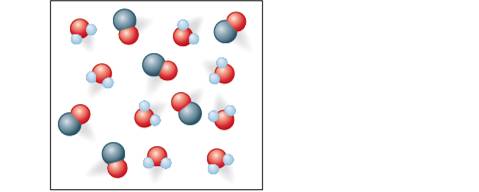
Consider the following reaction at some temperature:
Some molecules of

When equilibrium is reached, how many molecules of
Want to see the full answer?
Check out a sample textbook solution
Chapter 6 Solutions
Chemical Principles
- Kc = 5.6 1012 at 500 K for the dissociation of iodine molecules to iodine atoms. I2(g) 2 I(g) A mixture has [I2] = 0.020 mol/Land [I] = 2.0 108 mol/L. Is the reaction at equilibrium (at 500 K)? If not, which way must the reaction proceed to reach equilibrium?arrow_forwardA mixture of SO2, O2, and SO3 at 1000 K contains the gases at the following concentrations: [SO2] = 5.0 103 mol/L, [O2] = 1.9 103 mol/L, and [SO3] = 6.9 103 mol/L. Is the reaction at equilibrium? If not, which way will the reaction proceed to reach equilibrium? 2 SO2(g) + O2(g) 2 SO3(g) Kc = 279arrow_forwardFor the reaction N2(g)+3H2(g)2NH3(g) show that Kc = Kp(RT)2 Do not use the formula Kp = Kc(RT)5n given in the text. Start from the fact that Pi = [i]RT, where Pi is the partial pressure of substance i and [i] is its molar concentration. Substitute into Kc.arrow_forward
- A solution is prepared by dissolving 0.050 mol of diiodocyclohexane, C5H10I2, in the solvent CCl4.The total solution volume is 1.00 L When the reaction C6H10I2 C6H10 + I2 has come to equilibrium at 35 C, the concentration of I2 is 0.035 mol/L. (a) What are the concentrations of C6H10I2 and C6H10 at equilibrium? (b) Calculate Kc, the equilibrium constant.arrow_forwardNitrosyl chloride, NOC1, decomposes to NO and Cl2 at high temperatures. 2 NOCl(g) ⇌ 2 NO(g) + Cl2(g) Suppose you place 2.00 mol NOC1 in a 1.00–L flask, seal it, and raise the temperature to 462 °C. When equilibrium has been established, 0.66 mol NO is present. Calculate the equilibrium constant Kc for the decomposition reaction from these data.arrow_forwardFor the equilibrium 2 SO2(g) + O2(g) 2 SO3(g) Kc = 245 (at 1000 K) the equilibrium concentrations are [SO2] = 0.102, [O2] = 0.0132, and [SO3] = 0.184. The concentration of SO2 is suddenly doubled. Show that the forward reaction takes place to reach a new equilibrium.arrow_forward
- 12.103 Methanol, CH3OH, can be produced by the reaction of CO with H2, with the liberation of heat. All species in the reaction are gaseous. What effect will each of the following have on the equilibrium concentration of CO? (a) Pressure is increased, (b) volume of the reaction container is decreased, (c) heat is added, (d) the concentration of CO is increased, (e) some methanol is removed from the container, and (f) H2 is added.arrow_forwardThe reaction 2 NO2(g) N2O4(g) has an equilibrium constant, Kc, of 170 at 25 C. If 2.0 103 mol of NO2 is present in a 10.-L. Flask along with 1.5 103 mol of N2O4, is the system at equilibrium? If it is not at equilibrium, does the concentration of NO2 increase or decrease as the system proceeds to equilibrium?arrow_forwardThe equilibrium constant Kc for the synthesis of methanol, CH3OH. CO(g)+2H2(g)CH3OH(g) is 4.3 at 250C and 1.8 at 275C. Is this reaction endothermic or exothermic?arrow_forward
- For the reactionH2(g)+I2(g)2HI(g), consider two possibilities: (a) you mix 0.5 mole of each reactant. allow the system to come to equilibrium, and then add another mole of H2 and allow the system to reach equilibrium again. or (b) you mix 1.5 moles of H2 and 0.5 mole of I2 and allow the system to reach equilibrium. Will the final equilibrium mixture be different for the two procedures? Explain.arrow_forwardKc for the decomposition of ammonium hydrogen sulfide is 1.8 104 at 25 C. NH4HS(s) NH3(g) + H2S(g) (a) When the pure salt decomposes in a flask, what are the equilibrium concentrations of NH3 and H2S? (b) If NH4HS is placed in a flask already containing 0.020 mol/L of NH3 and then the system is allowed to come to equilibrium, what are the equilibrium concentrations of NH3 and H2S?arrow_forwardConsider the following reactions at some temperature: 2NOCl(g)2NO(g)+Cl2(g)K=1.6105 2NO(g)N2(g)+O2(g)K=11031 For each reaction, assume some quantities of the reactants were placed in separate containers and allowed to come to equilibrium. Describe the relative amounts of reactants and products that would be present at equilibrium. At equilibrium, which is faster, the forward or reverse reaction in each case?arrow_forward
 ChemistryChemistryISBN:9781305957404Author:Steven S. Zumdahl, Susan A. Zumdahl, Donald J. DeCostePublisher:Cengage Learning
ChemistryChemistryISBN:9781305957404Author:Steven S. Zumdahl, Susan A. Zumdahl, Donald J. DeCostePublisher:Cengage Learning Chemistry: An Atoms First ApproachChemistryISBN:9781305079243Author:Steven S. Zumdahl, Susan A. ZumdahlPublisher:Cengage Learning
Chemistry: An Atoms First ApproachChemistryISBN:9781305079243Author:Steven S. Zumdahl, Susan A. ZumdahlPublisher:Cengage Learning
 Chemistry: The Molecular ScienceChemistryISBN:9781285199047Author:John W. Moore, Conrad L. StanitskiPublisher:Cengage Learning
Chemistry: The Molecular ScienceChemistryISBN:9781285199047Author:John W. Moore, Conrad L. StanitskiPublisher:Cengage Learning Chemistry: Principles and PracticeChemistryISBN:9780534420123Author:Daniel L. Reger, Scott R. Goode, David W. Ball, Edward MercerPublisher:Cengage Learning
Chemistry: Principles and PracticeChemistryISBN:9780534420123Author:Daniel L. Reger, Scott R. Goode, David W. Ball, Edward MercerPublisher:Cengage Learning Chemistry & Chemical ReactivityChemistryISBN:9781337399074Author:John C. Kotz, Paul M. Treichel, John Townsend, David TreichelPublisher:Cengage Learning
Chemistry & Chemical ReactivityChemistryISBN:9781337399074Author:John C. Kotz, Paul M. Treichel, John Townsend, David TreichelPublisher:Cengage Learning





